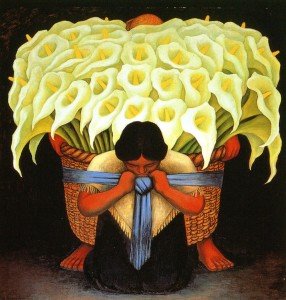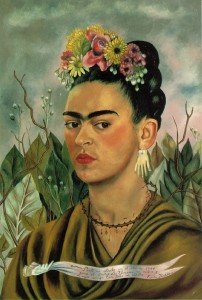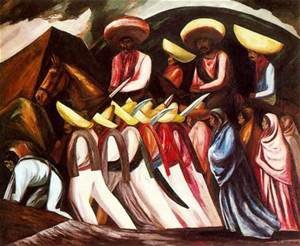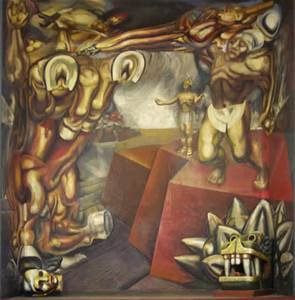For most of the 20th century it was assumed that modernism belonged to the Western Euro-American domain. However, there were junctures of global modernism that occurred in many hot spots around the globe: zones of interactions with modernization that prompted negotiations with one’s traditional culture and the rapid changes happening it. Travel, sometimes subsidized by national cultural programs, the exchange of ideas through books and film helped bring to the West disruptions of traditional Greco-Roman/European aesthetics while simultaneously invigorating artists in non-Western countries, who were coming to terms with their own changing world and identities. Wiley-Blackwell has published a wonderful overview in their Modern Art in Africa, Asia and Latin America: An Introduction to Global Modernisms.
The 1920’s, the 1950’s after the war, the late 60’s and early 70’s, the 80’s were all periods of intense change, idea migration and paradigm shifts. In Latin America many forms of art were impacted by political revolutions, oppression and wars. Native or Colonial styles of art were insufficient in communicating visually what was happening in these worlds, but would still serve as elements of the visual vocabulary. Modern art in these countries would use the visual arts to depict the negotiations and violence occurring to the Latin American psyche and spirit while also allowing the artist and viewer to transcend and challenge. These works are worth viewing outside of the Latin American contexts as the dynamics, passions, conflicts are not isolated, they are both relevant and inspiring for humanity at large.
MEXICO
José Vasconcelos, a writer, sociologist, historian, lawyer and philosopher was appointed minister of public education in 1921. Following the fragmentation of the civil war Vasconcelos commissioned many public murals, helping to establish a unifying Mexican art practice.

Diego Rivera, perhaps one of the most famous in part due to his work on commissioned public works in the 1920’s, had traveled to Europe in 1907 becoming acquainted with the work of Matisse, Picasso and Gaugin. While having some success in Europe as a cubist, the Mexican Revolution (1914-15) and the Russian Revolution (1917) transformed his calling to that of wishing to reflect the lives of the working class and native peoples of Mexico. Returning to Mexico to paint a series of public murals. During the 30’s and 40’s he was commissioned to paint murals in the United States, some were controversial due to his politics.

There is not enough space to devout to Frida Kahlo, a gifted Mexican artist who caught the eye of famous surrealists like Andre Breton. Kahlo however denied the surrealist label, she was not depicting her dreams she explained, she was depicting her reality. Raised by a German father and Mexican mother during the Mexican revolution, her mother domineering and depressive, Kahlo suffered from polio as a child. Her father encouraged her to engage in sports, bike riding, typically boy activities in order to regain her strength. However, later in her young life a traffic accident shattered her body and altered her life. Recovering in isolation and coping with the reoccurring pain Kahlo channeled everything into her artwork. Drawing upon Christian and Jewish themes as well as Mexican mythology, bright local colors and themes, Kahlo pioneered a very personal surrealist style that was well-received in both the U.S. and Paris.

Self Portrait, Kahlo, 1940
José Clemente Orozco was a painter who helped establish the Mexican muralist movement along with Rivera and Siqueiros. He was inspired by the Symbolist movement and was politically committed to helping the poor and working class. Of the three Mexican muralists, Orozco’s works were darker, more concerned with the bloody toll the Revolution was causing. Injured by fireworks chemicals during Mexican Independence Day celebrations he was unable to see a doctor for several days due to the festivities. Subsequently gangrene set in and he had to have his left hand amputated. He started painting political murals during the 20’s, his works were set apart by their focus on human suffering. After spending some years in New York and enjoying success painting murals in CA and New Hampshire he returned to Mexico where he was invited to paint the ceiling of the Government Palace in Guadalajara. The work was entitled The People and Its Leaders. Soon after he was asked to paint frescos inside Guadalajara’s Hospicio Cabañas. This would be considered his masterpiece, a “Sistine Chapel of the Americas,” depicting a panorama of Mexican history from pre-Colonial times through the Mexican Revolution.

David Alfaro Siqueiros was born in 1896 in Mexico. He was a social realist muralist and Mexican Communist. As a young teen he was inspired by the ideas of anarcho-syndicalism and the works of Dr. Atl who called for Mexican artists to develop their own national style. After the Mexican revolution he traveled to Paris where he met Diego Rivera and became acquainted with the styles of Cubism and Cezanne. In the 1930’s Siqueiros traveled to NY, where he ran a workshop for artists in preparation for the 1936 General Strike for Peace. Jackson Pollack attended the workshop learned the drip and pour technique from Siqueiros. In the late 30’s Siqueiros traveled to Spain to help fight against the Franco fascists before returning to work on murals. Later participating in a failed assassination attempt on Trotsky who was seeking asylum in Mexico forced Siqueiros into hiding.

